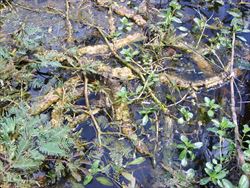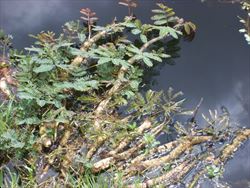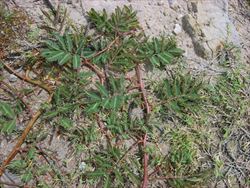Click on images to enlarge

habit (photo: Biosecurity Queensland)

leaves (photo: Biosecurity Queensland)

stems and leaves (photo: Biosecurity Queensland)

stems and leaves on land (photo: Biosecurity Queensland)
Scientific Name
Neptunia oleracea Lour. and Neptunia plena (L.) Benth.
Synonyms
Neptunia oleracea Lour.: Neptunia natans (L.f.) Druce; Mimosa natans L.f.; Neptunia prostrata (Lam.) Baill.; Mimosa prostrataLam.; Mimosa aquatica Pers.
Neptunia plena (L.)Benth.: Mimosa plena L.
Family
Fabaceae: sub-family Mimosoideae (New South Wales)
Leguminosae (South
Australia)
Mimosaceae (Queensland, the ACT, Victoria, Tasmania, Western
Australia and the Northern Territory)
Common Names
water Mimosa; water sensitive plant; dead and awake
Origin
Mexico, north and south America, widely cultivated and naturalised in Asia
Cultivation
Used as an vegetable in Asia, where it is cultivated mostly from cuttings
Naturalised Distribution
Water Mimosa (Neptunia oleracea ) is considered to be naturalised around Brisbane, although under eradication there, and N. plena is considered to be naturalised around Brisbane, Cairns and Darwin, similarly under eradication at site.
Habitat
Water bodies and riparian zones in the tropics and subtropics
Habit
Floating, prostrate or ascending perennial herb sometimes forming dense thickets 2-3m high.
Distinguishing Features
- forms thick floating mats on open water
- floating stems can be inflated with spongy white tissue, rooting at nodes
- leaves are finely divided and may be sensitive to touch
- flowers are yellow, in globose heads 1-2cm across
- pods are grouped and held erect, 2-4cm long and c. 1cm wide
- seeds are 4-8 per pod (N. oleracea) and 8-20 per pod (N. plena)
Stems and Leaves
Stems, leaves and leaflets are nearly hairless, or with some small hairs on leaflet margins. Stems are usually reddish on land, and inflated with white spongy tissue on water, often rooting at leaf nodes. Leaves are twice divided (bipinnate) with 2-4 pinnae per leaf , each with 12-25 leaflets per pinna. The leaves are alternate on the stem, but the pinna and leaflets are in opposite pairs. Neptunia plena has a gland on the petiole between the lowest pair of pinnae (absent in N. oleracea ). The leaflets are oblong, 7-12 mm long and 1.3-2.2 mm wide.
Flowers and Fruit
Flowers are grouped in obovoid to globose heads on erect peduncles 3-20 cm long. Each head has 30-50 flowers. The prominent stamens are yellow. The stamens are gland-tipped in N. plena .
Reproduction and Dispersal
Water Mimosa (Neptunia oleracea and N. plena) readily reproduces by seed or vegetatively from broken stems.
Environmental Impact
Water Mimosa (Neptunia oleracea and N. plena) poses a serious threat to waterways and wetlands. It forms thick mats that impede drainage, and replace native flora, excluding light and reducing oxygen in waterbodies.
Other Impacts
Water Mimosa (Neptunia oleracea and N. plena) is a nitrogen fixer, and can therefore increase nutrients in waterways. The hard seeds are likely to be long-lived.
Legislation
Water Mimosa (Neptunia oleracea and N. plena ) is declared under legislation in the following states and territories:
Management
Biosecurity Queensland fact sheet http://daff.qld.gov.au
Similar Species
Water Mimosa (Neptunia oleracea and N. plena ) are distinguished from native Neptunia species by the fleshy stems and larger pods ( > 2 cm long).
Common sensitive plant (Mimosa pudica) has pink flowers and hairy stems and pods.
Notes
Neptunia oleracea and Neptunia plena are difficult to tell apart if not in fruit: N. oleracea has 4-8 seeds per pod and N. plena has 88-20 seeds per pod. Neptunia plena also has a gland on the petiole between the lowest pair of pinnae, and and apical glands on the stamens althogh these tend to fall off.

